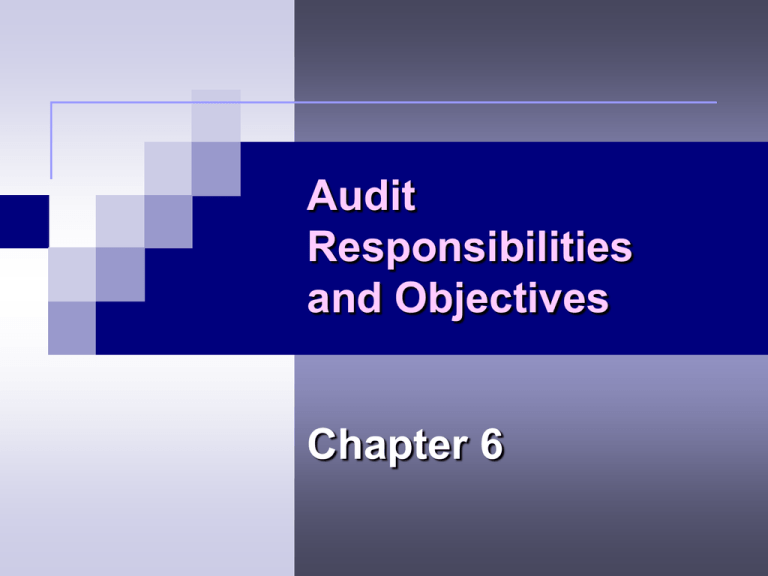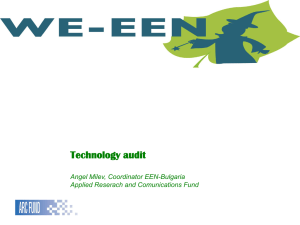Chapter 6 – Audit Responsibilities and Objectives
advertisement

Audit Responsibilities and Objectives Chapter 6 Key Topics in Chapter 6 Understand the responsibility of : Management, for the financial statements and internal controls The independent auditor: SAS 1 – auditor’s responsibility in performing the audit For discovering illegal acts Understand the four phases of a financial statement audit Key Topics in Chapter 6 Be familiar with the different transaction cycles Know the management assertions Know the general transaction-related and general balance-related audit objectives Objective of Conducting an Audit of Financial Statements The objective of the ordinary audit of financial statements is the expression of an opinion of the fairness with which they present fairly, in all respects, financial position, result of operations, and its cash flows in conformity with GAAP. Management’s Responsibilities Management is responsible for the financial statements and for internal control. The Sarbanes–Oxley Act increases management’s responsibility for the financial statements. It requires the CEO and the CFO of public companies to certify the quarterly and annual financial statements submitted to the SEC. Auditor’s Responsibilities Material versus immaterial misstatements Combined uncorrected errors likely to affect A user’s decision are usually considered material Errors vs. fraud Both are a potential source of material misstatement, however, fraud has further implications. Reasonable assurance Not a guarantee Professional skepticism The attitude we adopt in all aspects of the engagement Auditor’s Responsibilities for Discovering Illegal Acts Direct-effect vs. Indirect-effect illegal acts * Auditors have the same responsibility for detecting direct-effect illegal acts, as they do fraud. * Auditors provide no assurance indirect-effect illegal acts will be detected Evidence accumulation when there is no reason to believe indirect-effect illegal act exists * Inquiries of management and the B.O.D., reading the B.O.D. minutes. Auditor’s Responsibilities for Discovering Illegal Acts Actions when the auditor knows of an illegal act * Consider effects on the financial statements and disclosures. More evidence may be required. * Who you gonna tell? Within the client’s company Outside the client’s company Financial Statements Cycles Audits are performed by dividing the financial statements into smaller segments or components. Relationships Among Transaction Cycles General cash Capital acquisition and repayment cycle Sales and collection cycle Acquisition and payment cycle Inventory and warehousing cycle Payroll and personnel cycle Management Assertions 1. Existence or occurrence 2. Completeness 3. Valuation or allocation 4. Rights and obligations 5. Presentation and disclosure Transaction-Related Audit Objectives and Management Assertions General TransactionManagement Assertions Existence or occurrence Completeness Related Audit Objectives Existence Completeness Valuation or allocation Accuracy Classification Timing Posting and summarization Rights and obligations N/A Presentation and disclosure N/A Transaction-Related Audit Objectives and Management Assertions Existence Recorded transactions exist. Completeness Existing transactions are recorded. Accuracy Recorded transactions are stated at the correct amounts. Transaction-Related Audit Objectives and Management Assertions Classification Transactions are properly classified. Timing Transactions are recorded on the correct dates. Posting and summarization Transactions are included in the master files and are correctly summarized. Assertions and Balance-Related Audit Objectives Management Assertions Existence or occurrence Completeness General Balance Related Audit Objectives Existence Completeness Valuation or allocation Accuracy Classification Cut-off, Detail tie-in Realizable value Rights and obligations Rights and obligations Presentation and disclosure Presentation and disclosure General Balance-Related Audit Objectives Existence Amounts included exist. Completeness Existing amounts are included. Accuracy Amounts included are stated at the correct amounts. General Balance-Related Audit Objectives Classification Amounts are properly classified. Cutoff Transactions are recorded in the proper period. Detail tie-in Account balances agree with master file amounts, and with the general ledger. General Balance-Related Audit Objectives Realizable value Assets are included at estimated realizable value. Rights and obligations Assets must be owned. Presentation and disclosure Account balances and disclosures are presented in financial statements. Balance and Transactions Affecting Balances Example Accounts Receivable (in thousands) Beginning balance $ 17,521 Sales Ending balance $144,328 $ 20,197 $137,087 Cash receipts $ Sales returns 1,242 and allowances $ Charge-off of 3,323 uncollectible accounts How Audit Objectives Are Met The auditor must obtain sufficient competent audit evidence to support all management assertions in the financial statements. An audit process is a methodology for organizing an audit. Four Phases of a Financial Statement Audit Phase I Plan and design an audit approach. Perform analytical procedures and Phase III tests of details of balances. Phase II Perform tests of controls and substantive tests of transactions. Complete the Phase IV audit and issue an audit report. Announcements First midterm next Wednesday, Feb. 1. A topic guide that will summarize the main items that could be represented on the midterm will be available on the website within the next 2 days. Next class: guest professors from PwC will present material from Chapter 6.





